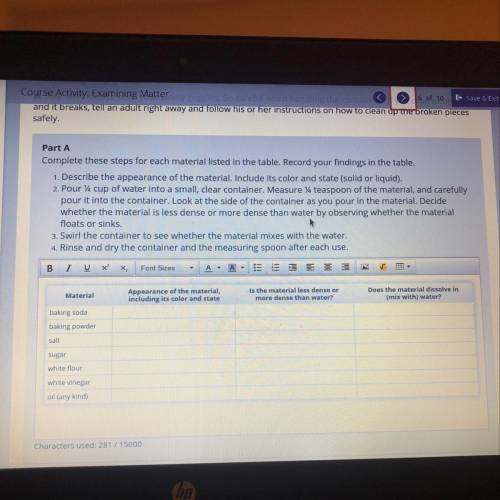
Part A
Complete these steps for each material listed in the table. Record your findings in the table.
1. Describe the appearance of the material. Include its color and state (solid or liquid).
2. Pour 14 cup of water into a small, clear container. Measure 14 teaspoon of the material, and carefully
pour it into the container. Look at the side of the container as you pour in the material. Decide
whether the material is less dense or more dense than water by observing whether the material
floats or sinks.
3. Swirl the container to see whether the material mixes with the water.
4. Rinse and dry the container and the measuring spoon after each use.
B
1
U
x?
X
Font Sizes
A
AM
E 2E 3
✓
Material
Appearance of the material,
including its color and state
Is the material less dense or
more dense than water?
Does the material dissolve in
(mix with) water?
baking soda
baking powder
salt
sugar
white flour
white vinegar
oil (any kind


Answers: 1
Other questions on the subject: Physics

Physics, 21.06.2019 14:10, mbonham481
Gam radio signals can usually be heard behind a hill, but fm often cannot. that is, am signals bend more than fm. explain. (radio signals, as we shall see, are carried by electromagnetic waves whose wavelength for am is typically 200 to 600 m and for fm about 3 m.)
Answers: 2

Physics, 22.06.2019 05:30, 444x4gang4
Because light travels in a straight line and casts a shadow, isaac newton hypothesized that light is
Answers: 1

Physics, 22.06.2019 09:20, Geo777
Question 11 of 13 (1 point) jump to question: a stairway, ladder, or ramp must be present in excavations in which of the following situations? a. all trenches must have access/egress b. the trench is more than 15 feet wide but only 1 ½ feet deep c. the trench is more than 4 feet deep and the devices must be within 25 feet of all workers
Answers: 1

Physics, 22.06.2019 14:40, akitchen10
A5 foot by 5 foot box culvert is buried 6 feet beneath the surface of the ground. a crosssection of this very long culvert (into and out of the page) is illustrated below. assume that the soil in which the culvert is buried has the following properties: jt = 120 pcf, w = 12%, ko = 0.50, ka = 0.33, and kp = 3.00. calculate the total horizontal force per unit length of culvert (fh) felt on one of the vertical faces of the culvert.
Answers: 1
Do you know the correct answer?
Part A
Complete these steps for each material listed in the table. Record your findings in the tabl...
Questions in other subjects:

Computers and Technology, 22.08.2019 01:30


Mathematics, 22.08.2019 01:30


Biology, 22.08.2019 01:30

History, 22.08.2019 01:30

English, 22.08.2019 01:30


Mathematics, 22.08.2019 01:30

Biology, 22.08.2019 01:30






